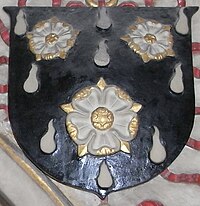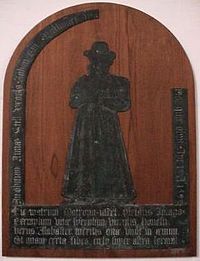
Quick Facts

Biography
John Still (c. 1543 – 26 February 1607/8), bishop of Bath and Wells, enjoyed considerable fame as a preacher and disputant. He was formerly reputed to be the author of the early English comedy drama Gammer Gurton's Needle (see below).
Career
He was born 1543 at Grantham, Lincolnshire. After finishing his schooling at The King's School, Grantham he became a student at Christ's College, Cambridge, where he graduated with a BA in 1562, MA in 1565, and DD degree in 1575. In 1561 he became a fellow of his college and took holy orders.
He was appointed in 1570 Lady Margaret's Professor of Divinity, subsequently held livings in Suffolk (where he was Archdeacon of Sudbury from 1576 to 1593) and Yorkshire, and was master successively of St John's College (1574) and of Trinity College (1577). Still was vice-chancellor of his university in 1575/6 and again in 1592/3, and was raised to the bishopric of Bath and Wells in 1593. In 1604 he purchased the manor of Hutton, Somerset, east of Wells and to the west of the Mendip Hills, with its residence of Hutton Court. He died on 26 February 1608, leaving a large fortune from lead mines discovered in the Mendips. There is a fine monument to Still in the north transept of Wells Cathedral, erected by his son Nathaniel.


Authorship of Gammer Gurton's Needle
Gammer Gurton's Needle is the second earliest extant English comedy, properly so called. Still, whose reputation as a serious churchman cannot easily be reconciled with the buffoonery in A Ryght Pithy, Pleasaunt and merie Comedie: Intytuled Gammer Gurtons Nedle, was first credited with its authorship by Isaac Reed in his 1782 edition of Biographia dramatica. The title-page of the piece, which was printed by Thomas Colwell in 1575, states that it was played not long ago at Christ's College, Cambridge, and was "made by Mr S. Mr of Art." A play was acted at Christmas 1567, and Still was identified as being the only MA on the register at that time whose name began with S.
There are reasons to suppose, however, that the play had been in Colwell's hands some time before it was printed, and it may well be identical with the Dyccon of Bedlam for which he took out a licence in 1562–3, "Diccon the Bedlem" being the first of the dramatis personae of Gammer Gurton. In the accounts of Christ's College for 1559–60 is the entry, "Spent at Mr Stevenson's plaie, 5s."
William Stevenson was born at Hunwick, Durham, matriculated in 1546, took his MA degree in 1553, and became BD in 1560. Stevenson was a fellow of Christ's College from 1559 to 1561, and is perhaps to be identified with a William Stevenson, who was a fellow from 1551 to 1554. If such is the case, there is reason to believe that the composition of Gammer Gurton's Needle should be ascribed to the earlier period. He was made prebendary of Durham in 1560–61, and died in 1575.
Contemporary Puritan writers in the Marprelate tracts allude to Dr John Bridges, Dean of Salisbury, author of A Defence of the Government of the Church of England, as the reputed author of Gammer Gurton's Needle, but he obviously could not be properly described as "Mr. S". Dr Bridges took his MA degree at Pembroke College, Cambridge, in 1560, and the witty and sometimes coarse character of his acknowledged work makes it reasonable to suppose that he may have been a coadjutor of the author.
In the light of the authorship discussion, Gammer Gurton's Needle is thought to have been produced in around 1553. Though it is less overt in its use of Latin comedic conventions than its contemporary Ralph Roister Doister, a number of scholars have noted the play's parodic treatment of Terentian comedy. The plot centres on the loss of a needle belonging to Gammer Gurton. It is eventually found when her servant, Hodge, is slapped on the buttocks by the trickster figure Diccon and discovers it in the seat of his breeches.
Family

John Still married twice:
- Firstly to Anne Alabaster (died 1592), (or Arblaster), daughter of Thomas Alabaster, a cloth merchant of Hadleigh, Suffolk. A monumental brass in her memory exists in Hadleigh Church. Her brother John Alabaster was twice mayor of Hadleigh. They had the following progeny:
- John (died young 1577–81), buried at Hadleigh.
- Nathaniel (1579–1626). Baptised at Hadleigh in 1579, died 1626 at Hutton, Somerset. He married Jane Whitmore (d.1639, buried Bath Abbey), a daughter of William Whitmore (d.1593), a haberdasher of Balmes Manor, Hackneyand of Apley Hall, Shropshire. Jane's nephew was Sir Thomas Whitmore, 1st Baronet (1612–1653). They had a son who died young, and five daughters and co-heiresses: (1) Anne (b. 1613) married John Codrington of Codrington and Didmarton, Glos., to whose family passed the manor of Hutton; (2) Jane (born 1614) married Sir James Pyle of Compton Beauchamp, Berks.; (3) Elizabeth (born 1618), living in 1639; (4) Daughter 4, unnamed; (5) Mary (born 1620?) married John Dennis (died 1660) of Pucklechurch, Glos., Sheriff of Gloucestershire and son of Henry Dennis (died 1638), who had married as his second wife Nathaniel's widow Jane. There is an incised stone mural tablet in baroque surround in Hutton Church depicting Nathaniel and his wife and children kneeling in prayer.
- Secondly after 1592, Jane Horner, daughter of Sir John Horner of Mells Manor, Somerset, High Sheriff of Somerset. They had the following progeny:
- John Still, of Shaston St James, buried in St James's Church, Shaftesbury. Married Margaret Grubham Howe, daughter of Sir George Howe, of Berwick St Leonard, Wilts., and sister of Sir George Grobham Howe, 1st Baronet (died 1676), MP for Hindon, Wilts., and of Berwick St Leonard, Wilts.
- Thomas Still (died 1631) of Somerton, Somerset. Buried at St James's, Shaftesbury. Married Bridget, daughter of Gawen Champernoune Esq. of Dartington, Devon by Lady Gabrielle Roberta Montgomery, daughter of Gabriel, comte de Montgomery (died 1574), a leader of the French Huguenots.
- Victoria County History, Middlesex, vol. 10, (1995) Hackney, Balmes Manor, pp. 33–35
- Ayers, James C., The Whitmore Story
- Vivian's 'Visitations of the County of Devon':Gawen Champernon, of Dartington in Com. Devon
Monument at Wells

In Wells Cathedral a large canopied tomb with a recumbent effigy of the bishop is situated against the east wall of the chapel which leads from the north aisle to the Chapter House. It was erected by Nathaniel Still, the bishop's son. It was repainted in the 19th century. It bears the following Latin inscription:
Memoriae sacrum Joanni Still Episcopo Bathoniensi et Wellensi, Sacras Theologia Doctori Acerrimo Christianae Veritatis propugnatori non minus vitas integritate quam veria doctrina claro qui cum Domino diu vigilasset in Christo spe certa resurgendi obdormivit die XXVI Februarii mdcvii Vixit annos LXIIII sedit episcopus XVI Nathaniel Still filius primogenitus optimo patri maerens pietatis ergo posuit
("Sacred to the memory of John Still Bishop of Bath and Wells, Doctor of Theology, keenest warrior for Christian Virtue famed not less in integrity of life than for True Doctrine who when he had long kept vigil with the Lord went to sleep in Christ on the 26th day of February 1607 in the certain hope of rising again. He lived for 64 years, sat as Bishop for 16. Nathaniel Still first-born son mourning the best father thus placed it of piety")
Above it are three escutcheons, left to right: 1st, Azure, a saltire per saltire and per cross counter changed argent and or (See of Wells); 2nd, the same, impaling Still; 3rd, Still, alone.
Monument to son

There exists a stone memorial to Nathaniel Still (d.1626), son of Bishop Still. Nathaniel kneels at prayer to left in front of his son, who predeceased him. Kneeling opposite is his wife Jane Whitmore in front of their daughters. Below is the following text, which alludes to the Bishop who "first raised the name" (of Still):
"In memory of Nathanill Still of this parrish Esq., who dyed the second day of February Anno Domini 1626. Not that he needeth monuments of stone for his well-gotten fame to rest uppon but this was reard to testifie that hee lives in theire loves ye yet surviving for unto vertu who first raised his name hee left the preservation of the same and to posterity remaine it shall when brass and marble monuments shall fall"
